Joshiraku 08 – notes and the like This entry was posted by Vale.
Well, here we go. It’s taken quite a while, but now everything’s back in order. Episode 8 is released and further episodes are in the making too. For now let’s just check the horribly punny eighth episode.
If you don’t recognize the girls sitting in the audience, then go and watch Sayonara Zetsubo Sensei right now (it’s written by the same guy as Joshiraku). Actually in the Joshiraku manga, every rakugo scene has some cameo appearances in the audience, while in the anime they just put the same guys all the time. Seeing the SZS girls is kinda refreshing. From right to left: Komori Kiri, Oura Kanako, Kobushi Abiru, Sekiutsu Maria Tarou, Fuura Kafuka, Kitsu Chiri and Otonashi Meru.
She doesn’t even get to say a whole word, just the last syllable.
Ito Yokado and Seven & i Holdings are Japanese companies.
They start with a punning scene right away. The center is shin (新, new).
She says two stations, Shin-Okubo and Shin-Kawasaki. They aren’t really “new”, and for example Shin-Okubo is only a minute’s walk from Okubo. It’s quite common in Japan to name stations like that, for example Shin-Osaka and Shin-Yokohama (just to mention a few you’re likely to encounter if you travel by train in Japan).
I don’t really know what happened here, but the second half of her sentence is kinda missing. She says that newspapers tend to be biased.
Okay, let me make something clear. In the case of this anime, where comedy is the center of everything, I think that keeping the script funny enjoys priority over literal accuracy. In this case a literal translation wouldn’t be funny at all and it wouldn’t even have any “new”s in it to connect it to the rest of the dialog. She lists sports, 新体操 (shintaisou, rhythmic gymnastics), 新卓球 (shin-takkyuu, lit. new table tennis, a modified version of table tennis) and synchronized swimming (which also starts with shin when transcribed to Japanese), and then Gankyou goes on to point out that in the latter the shin isn’t 新, just sounds the same.
And here we go again. Her part in the sentence was a “too” (and that was still the best choice), which required all their lines to be tweaked to that here. In Japanese, it was just the syllable su, which gave them quite a lot of freedom. Luckily except for Kigu’s line, it was possible to retain the original meanings. Kigu mentions 鯣 (surume, dried cuttlefish).
This one turned out quite good.
Well, she says “letters”, that’s why it’s 2 and 5 (for Yasu and Kumeta Kouji, the guy who draws and the guy who writes Joshiraku), but if you say syllable, it should be 2 and 6.
Remember the first half of the ending? The Jugemu-Jugemu part? Now that whole thing is the name in a rakugo story.
Kukuru and Gankyou teach you some Japanese. ポチ袋 (pochi-bukuro) are those envelopes, and the pochi is from another phrase (これっぽっち koreppocchi) that means “close to nothing”. 粗品 (soshina) is a modest way of calling a present you give, literally “bad product”. The Japanese are really modest when it comes to stuff like this.
The last performer, the star of the show is called the 取り (tori), which is a homophone to 鳥, bird.
The 2000 yen bill isn’t in circulation anymore, so if you happen by one, that’s usually considered huge luck. It’s true though that vending machines don’t accept it anymore.
Many of those expensive Ginza clubs went down when the economic bubble collapsed in Japan.
Tatami mats have standard sizes and are used as the common means to measure the area of an apartment. Mine is 8.
I’d generally refrain from translating location names, but in this case the 地蔵 (jizou) in it refers to the protector deity that’s mentioned later. The full name is Sugamo Jizou Avenue Shopping Street. The Sugamon Tetora mentions is its mascot character.
They’re punning on that maid (meido) and 冥土 (underworld) are homophones.
Just how drugged do you have to be for that?
The point is that their eyes met, not that she looked on them.
刺抜地蔵 (togenuki jizou).
This is a reference to the Yuukian (有機庵) restaurant that’s really there.
Again, the second half of the sentence is mysteriously missing. “… but I feel so much older now.”
Mei and Satsuki are from Totoro. Both of their names mean May (Mei’s sounds the same, and Satsuki is an old Japanese name for May).
It’s a Kumeta inside joke.
That’s the eleventh ending of Sora no Otoshimono, Champion by Alice.


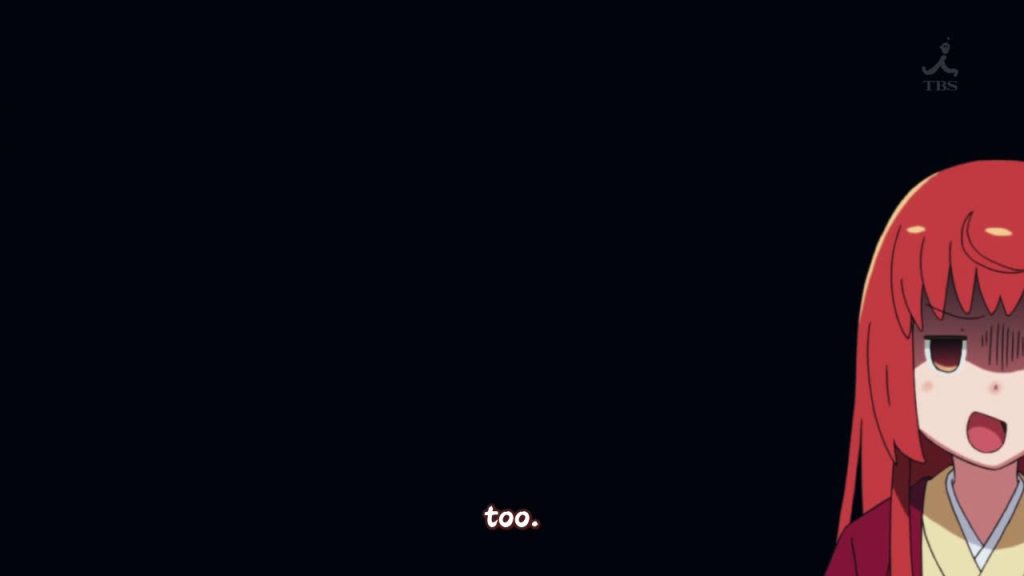
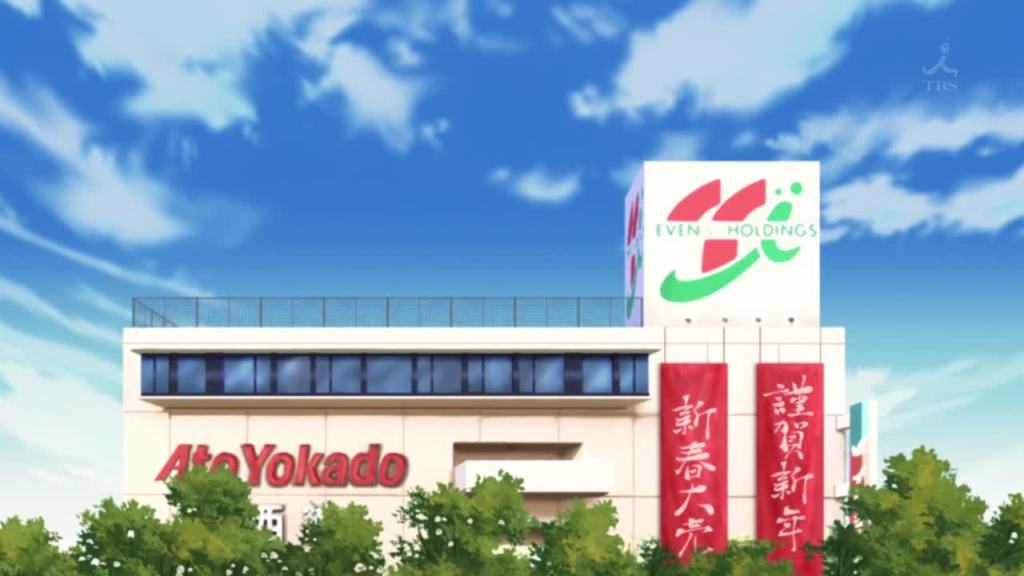


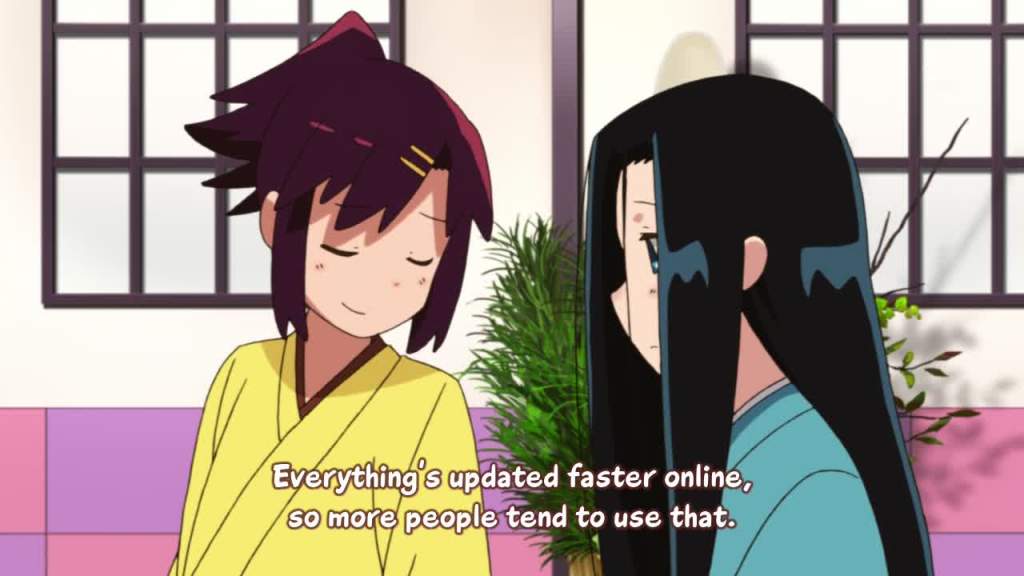


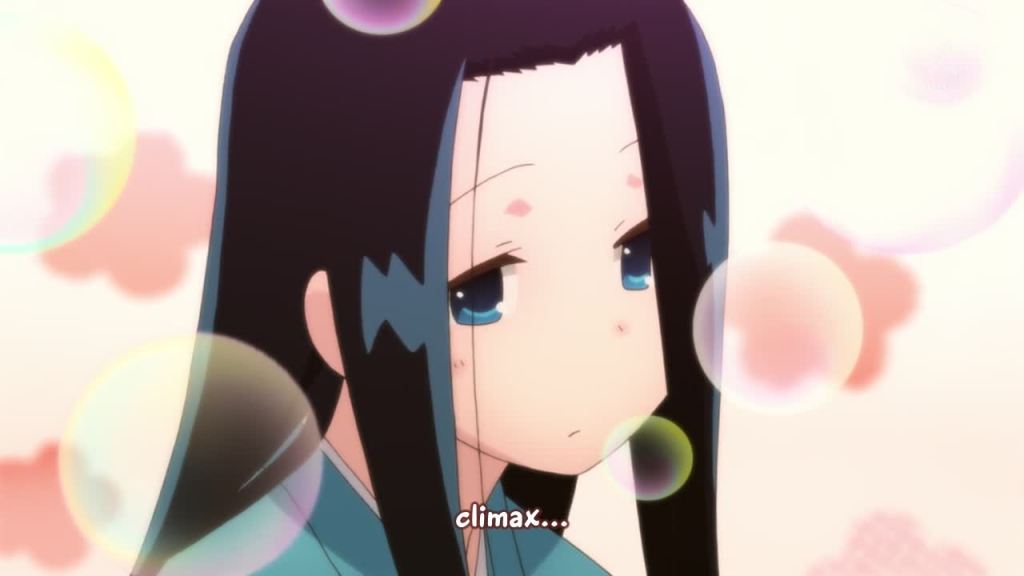
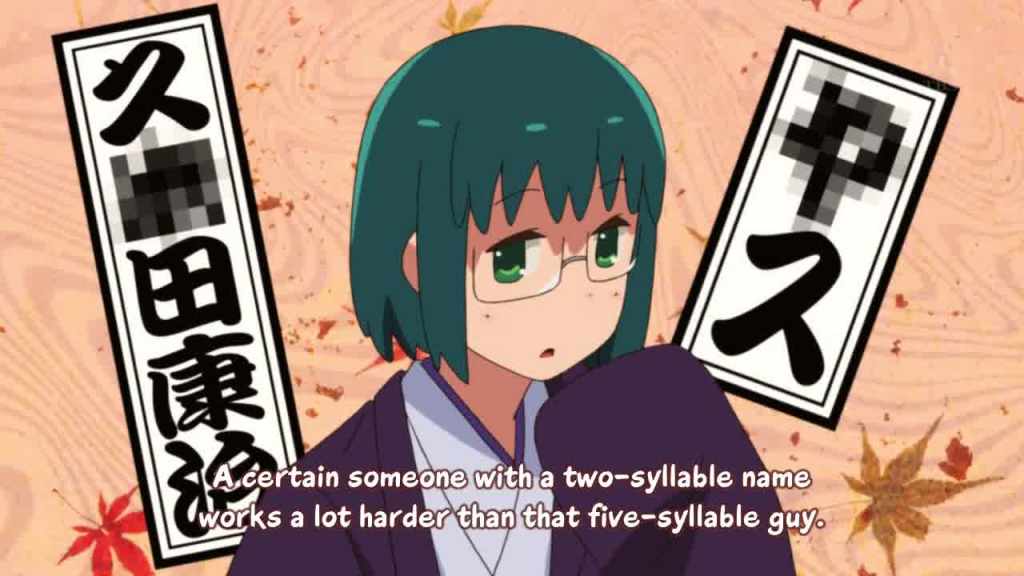


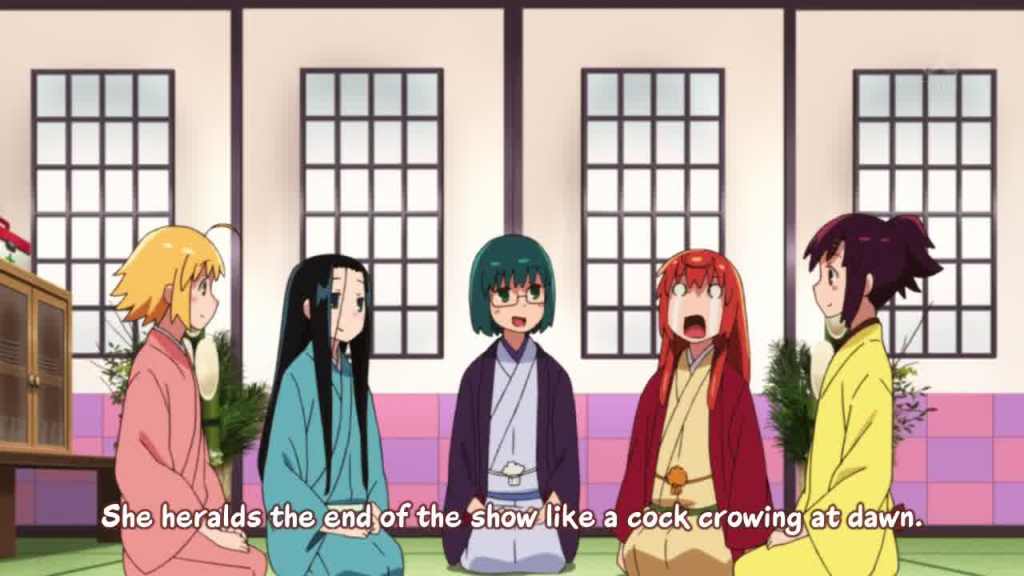





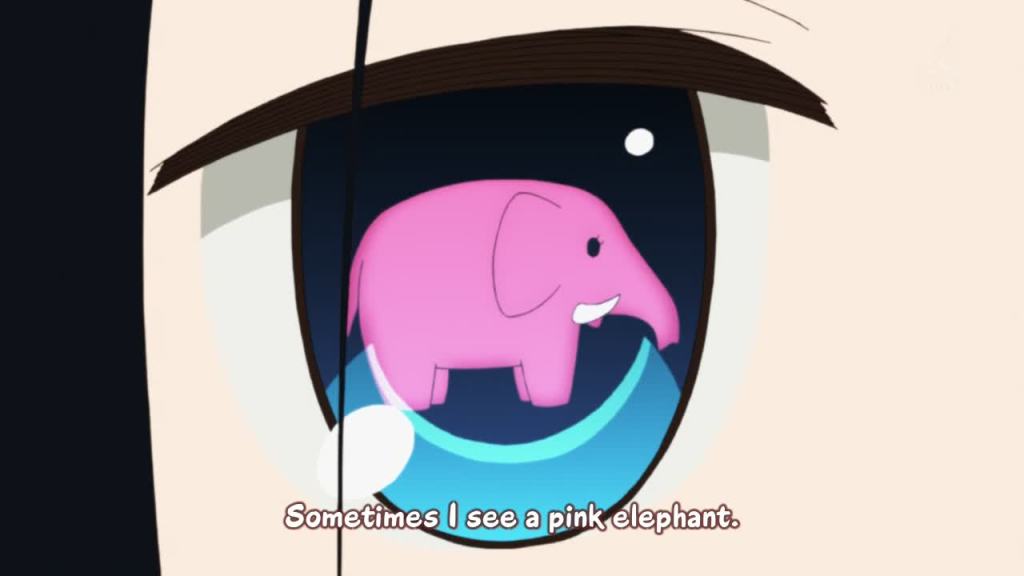
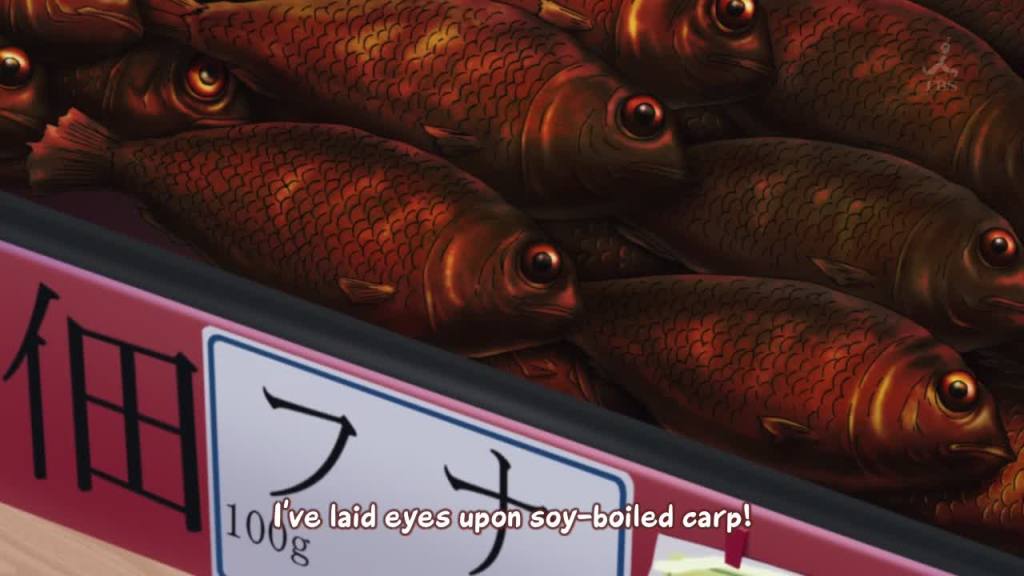






I think kukuru’s pink elephant is a reference to LSD dream emulator
http://en.wikipedia.org/wiki/Seeing_pink_elephants
Thanks for your efforts. More notes (and a few questions) in return:
* 1:30: Cultural aspect (CA; not necessary for understanding this instalment, but interesting nonetheless): The decoration in the background is characteristic for the Japanese New Year. Its name is kadomatsu (門松).
* 1:49: CA: Another traditional Japanese decoration called kagamimochi (鏡餅). More info: see Wikipedia.
* 2:03: “New game” for shindai (新台) is a bit vague. It’s a pachinko term which means “new pachinko machine”. This is equal to a high chance of getting some cash from it. That’s why pachinko parlours advertise with “shindai” in trains. At grand openings or after a renovation (新装開店, shinsôkaiten) all machines are shindai. So there’s no wonder Gankyô “wants to look into them” and grins like a madman at 2:06.
* 2:34: Resumption of the window gag from episode 4 (Fuji-san, Tokyo Skytree, Tokyo Tower): This time it’s the AtoYokado from 1:46, which can’t be seen through a window of the Shinjuku Suehirotei.
* 6:23: “The 2000 yen bill isn’t in circulation anymore” – Really? When did this happen? I thought you can get them in every bank.
* 7:13: The hanging scroll left to Kigurumi reads “Happy New Year! (謹賀新年, kingashinnen; compare with 9:27).
* 7:20: CA: Coins: http://www.mint.go.jp/eng/data/commemorative/page67.html, http://www.mint.go.jp/eng/data/commemorative/page14.html, http://www.mint.go.jp/eng/data/commemorative/page03.html and http://www.mof.go.jp/english/currency/coin/commemorative_coins/ekk240529.html (2nd series, 10,000 Yen).
* 8:18: A “luxury penthouse” with 6 tatami!? You’ve exaggerated with your translation of manshon (マンション) a bit too much at 8:10. How about “modern apartment”?
* 10:13: BGM: “Träumerei” by Robert Schumann. No connection to Hitô Nami.
* 10:42: I’m sorry, but I cannot see how you gain anything from interpreting Jizô (地蔵) as “Protector [of travellers, small deceased children still waiting on the banks of the Sanzu, fire fighters, etc.]”. Togenuki Jizô (とげぬき地蔵) isn’t even a “Thorn Protector”. He doesn’t protect (from) “thorns” (= illnesses), he pulls them out (togenuki = thorn removal). The street itself is associated with Jizô (see also 11:21), not just with a (any) protector.
Beside the fact that changing or translating a name is disrespectful (in this case it abuts blasphemy, but I wouldn’t go that far – but some might consider it this way), it is also irritating (Search for “Protector Street” or “Thorn Protector” and you will get nothing useful, “Jizô-dôri” or “Togenuki Jizô” on the other hand will get you a lot to read). So translating names like Jizô seems to be pointless, I think. George Gershwin, for example, isn’t Farmer Gershwin. Of course there are exceptions like already established terms (e.g. Jesus (Yeshua (the “a” should be an ayin)), Naples (Napoli) or even Jizô (Ksitigarbha; both literally mean “Earth Store”)) or when a product name sounds like something unappetising in another language (e.g. Calpis (カルピス), a beverage, sounds similar to “cow piss” in English, so they named it Calpico. Pocky (ポッキー), a snack, which should be familiar to “Joshiraku” viewers (see episodes 4 and 10), sounds similar to “Pocken [Engl. smallpox]” in German, so they called it Mikado.), but this doesn’t apply here. So what’s the advantage in translating Jizô? What trumps abovementioned disadvantages?
* 10:44: Tetora just says “It is Sugamo (巣鴨だよ, Sugamo da yo).” Sugamon, the duckling mascot of Sugamo (a district of Toshima, Tokyo), appears after that on the banners next to his gigantic rump (11:17), which is a tourist attraction right next to the entrance gate of Jizô-dôri. You can spot it (the hut) between Marii and Tetora.
* 11:21: CA: The pillar reads “Edo’s six Jizô (statues) (江戸六地藏尊, Edo roku Jizô-son)”. Between 1708 and 1720 six bronze Jizô statues were erected next to six temples, at the entrances of the six highways (Nakasendô, Tôkaidô, Chiba-kaidô, Mito-kaidô and the other two I forgot – sorry about that) leading to Edo (= today’s Tokyo). The entrance to the temple Shinsô-ji (眞性寺) with its 2.68 m high Jizô statue is just a few steps behind this pillar.
* 13:08: “Doesn’t sound like sweets”: I’m told this refers to the expression Kintarô-ameteki (金太郎飴的), literally “like Kintarô candy”, which describes an inflexible person who isn’t able of coming up with an opinion of his own on any topic, someone lacking personality, thus an unattractive person.
* 14:00: BGM: “Ellens dritter Gesang ‘Hymne an die Jungfrau’” by Franz Schubert. Its first two words: “Ave Maria”. Now everyone should know why this song fits perfectly here.
* 16:10: CA: Tetora plays one of Japan’s traditional instruments, the 13-string koto (琴).
* 16:18: Window gag: Tokyo Dome (more visible at 18:00).
* 18:45: White crocodile: Reference to the mangaka Eguchi Hisashi (江口 寿史) who is said to have seen white crocodiles out of fear of a blank manuscript. He used this in his work “Stop!! Hibari-kun! (ストップ!! ひばりくん!)”, where yakuza boss Ôzora Ibari (大空 いばり) sees those living leather bags when he’s stressed (which happens frequently, mostly because of his son Hibari).
* 18:46: “The Green Cat (緑の猫, Midori no Neko)” is a science-fiction story from 1956 in Tezuka Osamu’s (手塚 治虫) series “Lion Books (ライオンブックス)”. In return for fulfilling your wishes the eponymous creature deprives you of your self-reliance.
* 18:47: Yamashita is a fictional character Maeda-kun, Kumeta’s assistant, dreamt of during work. Back in reality, but still half asleep, he informed Kumeta that he would quit, if Kumeta wouldn’t sack Yamashita.
* 19:38: Reference to chapter 7 (episode 3).
* 21:39: The poster on the telephone pole reads “Imai dentistry (今井歯科, Imai shika)”. Maybe a “-shika” pun like those in episode 10? I don’t know.
I thought that the jugem joke was about a certain monkey of another anime